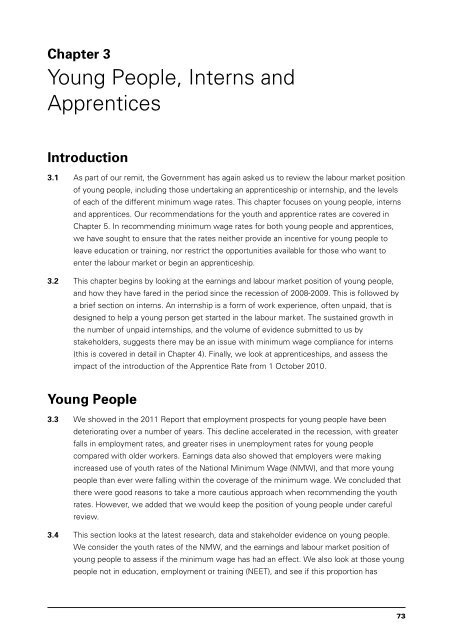National Minimum Wage
National Minimum Wage
National Minimum Wage
You also want an ePaper? Increase the reach of your titles
YUMPU automatically turns print PDFs into web optimized ePapers that Google loves.
Chapter 3<br />
Young People, Interns and<br />
Apprentices<br />
Introduction<br />
3.1 As part of our remit, the Government has again asked us to review the labour market position<br />
of young people, including those undertaking an apprenticeship or internship, and the levels<br />
of each of the different minimum wage rates. This chapter focuses on young people, interns<br />
and apprentices. Our recommendations for the youth and apprentice rates are covered in<br />
Chapter 5. In recommending minimum wage rates for both young people and apprentices,<br />
we have sought to ensure that the rates neither provide an incentive for young people to<br />
leave education or training, nor restrict the opportunities available for those who want to<br />
enter the labour market or begin an apprenticeship.<br />
3.2 This chapter begins by looking at the earnings and labour market position of young people,<br />
and how they have fared in the period since the recession of 2008-2009. This is followed by<br />
a brief section on interns. An internship is a form of work experience, often unpaid, that is<br />
designed to help a young person get started in the labour market. The sustained growth in<br />
the number of unpaid internships, and the volume of evidence submitted to us by<br />
stakeholders, suggests there may be an issue with minimum wage compliance for interns<br />
(this is covered in detail in Chapter 4). Finally, we look at apprenticeships, and assess the<br />
impact of the introduction of the Apprentice Rate from 1 October 2010.<br />
Young People<br />
3.3 We showed in the 2011 Report that employment prospects for young people have been<br />
deteriorating over a number of years. This decline accelerated in the recession, with greater<br />
falls in employment rates, and greater rises in unemployment rates for young people<br />
compared with older workers. Earnings data also showed that employers were making<br />
increased use of youth rates of the <strong>National</strong> <strong>Minimum</strong> <strong>Wage</strong> (NMW), and that more young<br />
people than ever were falling within the coverage of the minimum wage. We concluded that<br />
there were good reasons to take a more cautious approach when recommending the youth<br />
rates. However, we added that we would keep the position of young people under careful<br />
review.<br />
3.4 This section looks at the latest research, data and stakeholder evidence on young people.<br />
We consider the youth rates of the NMW, and the earnings and labour market position of<br />
young people to assess if the minimum wage has had an effect. We also look at those young<br />
people not in education, employment or training (NEET), and see if this proportion has<br />
73


